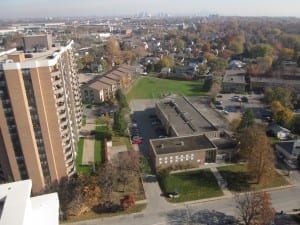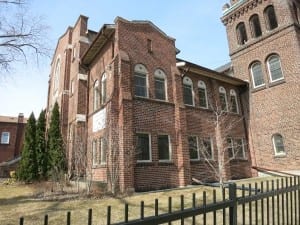My interest in the Wesley Mimico United Church redevelopment process began with my involvement with the Parkview School project
This blog post describes how I developed an interest in the unfolding story involving the redevelopment of the Wesley Mimico United Church located at 2 Station Road in Mimico.
I live in Long Branch, not Mimico. I’m not a member of the United Church. Yet the story of the church is of much interest to me.
Parkview School in October 2010

Parkview School (currently renamed St. Josaphat Catholic School) as it appeared in November 2010. Texts and an online video dealing with the archaeological remains of the Colonel Samuel Smith homestead located under the school grounds - in the green space you can see in this photo - dating from 1797 after the American Revolutionary War can be found at the Preserved Stories website. Jaan Pill photo
I regularly send out news updates to an email distribution list that I set up in November 2010 in connection with efforts to ensure that Parkview School (now St. Josaphat Catholic School, which opened in September 2012) at 85 Forty First Street in Long Branch remains in public hands.
I became interested in the next steps for the school when I learned in October 2010 that it had been declared surplus to the needs of the Toronto District School Board and was going to be sold.
The Parkview story reached a welcome conclusion in August 2011. At that time, Etobicoke-Lakeshore MPP Laurel Broten announced that the provincial government would provide $5.2 million to ensure that the Toronto District School Board would be able to sell the school to the French-language public school board Conseil scolaire Viamonde. The school is currently operated by the Toronto Catholic District School Board.
Along with MPP Laurel Broten, Ward 3 TDSB Trustee Pamela Gough also played a key role in ensuring the successful outcome, which prevented the school from being sold to a private developer for construction of a condo or townhouses.
During the latter project, which involved a two-stage letter writing campaign involving supporters as far away as Yellowknife in the Northwest Territories, I established contact with a number of people whose views I’ve learned to trust.
I’ve taken account of their views in arriving at my own view about Wesley Mimico.
I first learned about the church’s plans for redevelopment in February 2012

The section of Wesley Mimico United Church that faces Mimico Avenue was completed in 1953. The earlier part of the church, including the bell tower, facing Station Road, was completed in 1922. The bricks in the two sections of the church have slightly different colours. Jaan Pill photo
Around February 2012 I learned, from a Mimico resident who contacted me through my email list, about redevelopment plans that had been proposed regarding Wesley Mimico United Church.
At the time, the plan was for the church to be demolished with the exception of the bell tower, with a new multi-storey building offering housing for seniors to be built upon the site. Local residents that I met at this time expressed strong opposition to the proposal, which they viewed as the proposed destruction of a large part of a local heritage building.
When I began, around February 2012, to circulate information about Wesley Mimico through my email distribution list, I received feedback from several people I had consulted with during the Parkview School project. They shared with me a more nuanced view of the Wesley Mimico story that I otherwise would have been able to obtain. I place tremendous value on things that I can learn from other people.
Preliminary research regarding the Wesley Mimico redevelopment
My preliminary research concerning the Wesley Mimico church story highlighted several facts.
(1) First, a church congregation in the role of property owner is going to look at things from the perspective of an owner and developer.
(2) Secondly, a congregation will also look at things from the perspective of a resident. Thus a congregation would have a dual role – the role of owner / developer and of resident.
(3) Thirdly, I read about the history of church properties across Canada. What stayed in mind is that when churches have been unable to maintain their buildings because of rising maintenance costs and declining membership, various scenarios have unfolded.
Sometimes congregations have taken into account the desire of local communities to ensure historic church buildings are preserved. In some cases residents’ desires have been ignored – and sometimes solutions have emerged that satisfy both congregations and residents in the neighbourhood.
(4) It’s useful for stakeholders in any redevelopment project to have access to accurate and balanced information.
In a recent blog post I’ve outlined the church’s current redevelopment plans.
In subsequent posts I’ll discuss some of the historical features of the church, some features of heritage preservation legislation in Ontario, and my views regarding the proposed designation of the church building under the Ontario Heritage Act.

Leave a Reply
Want to join the discussion?Feel free to contribute!